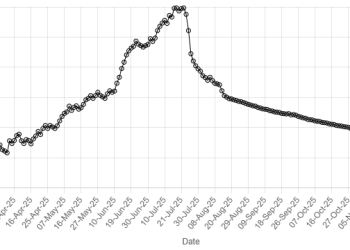Technology stocks retreated in choppy trading on Thursday, pressuring the benchmark S&P 500 and the Nasdaq indexes, while the Dow inched up after jobless claims data raised hopes for the U.S. Federal Reserve’s rate cuts.
The Nasdaq touched fresh intraday record highs shortly after open, however, initial gains fizzled out due to a 1.5% loss in Nvidia, which had crossed $3 trillion in market valuation in the previous session and overtaken Apple as the world’s second most valuable company.
Gains in Nvidia and other AI-related players have largely driven Wall Street’s rally this year, with the chipmaker accounting for roughly a third of the S&P 500’s over 12% year-to-date gains.
Seven out of the 11 S&P 500 sectors were in gains, led by a 0.6% rise in communication services, while the technology sector led declines with a 0.5% dip, after sharp gains on Wednesday.
“There’s just a lot of momentum and high sentiment in the semiconductor space, and while over the intermediate term you’ll need to bring some of that into check, in the near term, those types of things can really run,” said Ross Mayfield, investment strategy analyst at Baird.
Gains in software companies, including a 3.0% rise in Salesforce, helped the blue-chip Dow outperform.
Wall Street slips in choppy trading
On the data front, jobless claims rose more than expected to a seasonally adjusted 229,000 for the week ended June 1, the Labor Department said, the latest in a string of reports indicating tightness in the labor market is reducing, giving the Fed more room to cut rates.
The attention has now turned to the crucial nonfarm payrolls report due Friday.
Traders see a 70% chance of a September rate reduction, according to the CME’s FedWatch tool, and have priced in about two cuts this year, as per data from LSEG. Forecasters polled by Reuters also expect two cuts.
Some market participants also pointed to growing pressure for the Fed with both the European Central Bank and Bank of Canada beginning easing cycles.
“If you get too much divergences among the major economies, it can start to put pressure on different pockets of the economy…it might make something like a (Fed) September cut a little more obvious,” Mayfield said.









